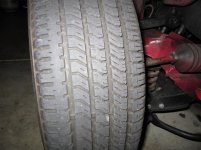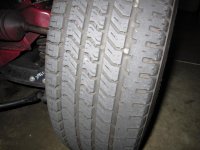DanLewis
Jedi Trainee
Offline
The tires on my Bugeye are wearing faster on the outside edges, suggesting that there is excessive positive camber. I don't think it's due to any physical damage to the car since there's no evidence of damage and because both tires are exhibiting the same amount of wear in exactly the same way (see below). Is it possible that this might simply be due to coil springs that have weakened with age?


The A-arms (aka wishbones) and spindles were replaced less than a year ago with ones from a Midget when the car was converted to disc brakes. All new bushings were installed at the same time. Is there any chance that the later A-arms are a bit different (i.e., shorter) that might explain the positive camber?
I know that the Bugeye front suspension does not have any adjustment for camber or caster, although Moss does sell A-arm bushings with offset holes that allow one to adjust the camber. Does anyone have experience using these bushings to adjust camber in a Bugeye or Midget?
Thanks!
Dan


The A-arms (aka wishbones) and spindles were replaced less than a year ago with ones from a Midget when the car was converted to disc brakes. All new bushings were installed at the same time. Is there any chance that the later A-arms are a bit different (i.e., shorter) that might explain the positive camber?
I know that the Bugeye front suspension does not have any adjustment for camber or caster, although Moss does sell A-arm bushings with offset holes that allow one to adjust the camber. Does anyone have experience using these bushings to adjust camber in a Bugeye or Midget?
Thanks!
Dan

 Hi Guest!
Hi Guest!

 smilie in place of the real @
smilie in place of the real @
 Pretty Please - add it to our Events forum(s) and add to the calendar! >>
Pretty Please - add it to our Events forum(s) and add to the calendar! >> 
